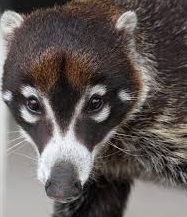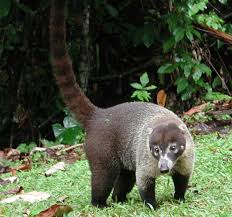
Coatimundi
(Nasua narica)

The white-nosed coati, also known as the coatimundi is a species of coati and a member of the family Procyonidae (raccoons and relatives). Local names include pizote, antoon, and tejón. It weighs about 4-6 kg (8.8-13.2 lb). However, males are much larger than females, and small females weigh as little as 2.5 kg (5.5 lb) and large males as much as 12.2 kg (27 lb). On average, the total length is about 110 cm (43 in), about half of that being the tail length.
Conservation status
Least concern
Scientific classification |
|
| Kingdom: | Animalia |
| Phylum: | Chordata |
| Class: | Mammalia |
| Order: | Carnivora |
| Family: | Procyonidae |
| Genus: | Nasua |
| Specie: | Nasua narica |
Description

The white-nosed coati is a member of the raccoon family. Its body is one and a half to two feet long and its tail is two feet long. It holds its long, thin, ringed tail upright when it is walking.
It has small ears, long, sharp claws, and a long, pointed snout that tilts up a little at the tip. It has a black mask and white around its eyes, nose and on the inside of its ears. Its fur is brown with a mix of red and yellow on top and a lighter brown on its undersides. Its lower legs and the tops of its feet are blackish-brown. Males and females look alike but males are much larger.
Behavior

Although the white-nosed coati spends a lot of time on the ground looking for food, it is also a very good tree climber and swimmer! Its long tail helps it keep its balance. It usually spends the night sleeping in a tree.
The male coati is solitary, but females and their young live and travel in packs of 4-40 individuals. They will often take a break from foraging for food to groom each other.
Unlike most members of the raccoon family, the coati is active during the day, although adults may find a shady spot to nap when it gets too hot! Young coati are very playful and spend a lot of time chasing and wrestling with each other.
Habitat and range
White-nosed coatis inhabit wooded areas (dry and moist forests) of the Americas. They are found at any altitude from sea level to 3,000 m (9,800 ft), and from as far north as southeastern Arizona and New Mexico, through Mexico and Central America, to far northwestern Colombia (Gulf of Urabá region, near Colombian border with Panama). There has been considerable confusion over its southern range limit, but specimen records from most of Colombia (only exception is far northwest) and Ecuador are all South American coatis.Coatis from Cozumel Island have been treated as a separate species, the Cozumel Island coati, but the vast majority of recent authorities treat it as a subspecies, N. narica nelsoni, of the white-nosed coati. They are smaller than white-nosed coatis from the adjacent mainland (N. n. yucatanica), but when compared more widely to white-nosed coatis the difference in size is not as clear. The level of other differences also support its status as a subspecies rather than separate species.
White-nosed coatis have also been found in the U.S. state of Florida, where they are an introduced species. It is unknown precisely when introduction occurred; an early specimen in the Florida Museum of Natural History, labeled an "escaped captive", dates to 1928. There are several later documented cases of coatis escaping captivity, and since the 1970s there have been a number of sightings, and several live and dead specimens of various ages have been found. These reports have occurred over a wide area of southern Florida, and there is probable evidence of breeding, indicating that the population is well established.
Diet

The white-nosed coati is omnivorous. It uses its long snout and sharp claws to forage for food. It often sniffs along the ground, pushing leaf litter out of their way as it roots for prey like beetles, grubs, ants, termites, spiders and scorpions. When it smells something underground, it uses its sharp claws to dig out the prey. The white-nosed coati's diet also includes lizards, snakes, carrion, rodents, nuts and fruits. One of its favorite fruits is prickly pear, in fact, it will return to the same tree again and again until the tree is stripped bare.
Life cycle

The white-nosed coati mates between January and March. Males will join female family bands. The male will warn off competing males by baring his teeth, rearing up on his hind legs and turning up the end of his snout.
Once the male has mated, the females in the band will force him to leave the group. When the female is ready to give birth, she will leave the band. She has a litter of 2-6 young about 77 days after mating. She will usually have her litter in a nest made in the crevice of a tree. The young will be able to leave the tree when they are four weeks old.
The mother and her pups will rejoin the band when the pups are five to six weeks old. The pups are weaned when they are about four months old, but they will stay with their mother until she leaves the band to give birth to her next litter. The white-nosed coati's life expectancy is about 14 years.
Zoológico de Vallarta A. C.
Leave your comments, your opinion is important to us

